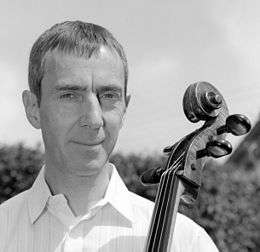Cello Concerto (Waterhouse)
The Cello Concerto, Op. 27, is a concerto for cello and orchestra by Graham Waterhouse, composed in 1990. It was first performed in 1995 in Toluca and Mexico City with the composer as the soloist, and published by Friedrich Hofmeister Musikverlag in Leipzig in 2000.[1]
| Cello Concerto | |
|---|---|
| by Graham Waterhouse | |
 Composer Graham Waterhouse, 2011 | |
| Catalogue |
|
| Year |
|
| Period | contemporary |
| Performed | 1995 |
| Published | 2000 in Leipzig by Friedrich Hofmeister Musikverlag |
| Movements | 3 |
History
The composer wrote a cello concerto in 1990 and played the solo part in the premiere in Yverdon, Switzerland, in June that year. He revised the work considerably, mentored by Siegfried Palm. He first performed the revised version in Toluca and Mexico City[2] in June 1995 with the Orquesta Sinfónica del Estado de Mexico, conducted by Peter Robinson, along with Mozart's Symphony No. 38 and Stravinsky's Firebird Suite.[3] The concerto was published by Friedrich Hofmeister Musikverlag in Leipzig in 2000.[1] Waterhouse played the concerto also in Nizhny Novgorod, Weimar and Baden-Baden.[4][5]
Hofmeister published a version for cello and piano,[6] which has been performed also with cello and organ.[6] A version for cello and chamber orchestra, Op. 27a, was first performed in Idstein on 5 August 2005 by the Rumänische Nationalphilharmonie Oltenia, conducted by Angela Gehann-Dernbach.[7]
Waterhouse was the soloist of the first performance in the UK on 9 February 2008 at The Dome in Cambridge, played by The Orchestra on the Hill, the combined orchestra of colleges including Churchill[8] where the composer studied[5] Conductor Dominic Wyse also directed Bernstein's Chichester Psalms in that concert.[8] He played the first performance in London, where he grew up, on 29 November 2015, with the North London Sinfonia.[9]
Music
The concerto is structured in three movements, after the model of solo concertos of the classical period:
- Adagio – Allegro moderato
- Andante tranquillo
- Allegro con brio
The first movement has a slow introduction, with the soloist entering freely like in a cadenza over long chords of the winds. A dotted motif is first played by cellos and basses, connects introduction and the Allegro in sonata form, is part of the main theme and dominates as an ostinato part of the development. The second movement is in song form. A motif of a downward tritone appears in a theme played first by the oboe, also in the first entrance of the cello which resembles improvisation, and in the cello's following cantilena. The movement is subdued and shaped by solo wind lines. The last movement plays with the rondo form. An energetic first theme contrasts to a lyrical episode.
According to the publisher, the composer shared the musical material between the soloist and the orchestra as equal partners, with concertante parts especially for the winds. The duration is given as 30 minutes.[6]
References
- "Cello Concerto op. 27 / Part". Friedrich Hofmeister Musikverlag. Archived from the original on 2 August 2017. Retrieved 20 November 2015.
- "Contemporary Music". Friedrich Hofmeister Musikverlag. p. 30. Archived from the original on 3 March 2016. Retrieved 22 November 2015.
- Temporada LXXII, Programa 7 (in Spanish). Orquesta Sinfónica del Estado de Mexico. 9 June 1995.
- "Prima la Musica" (PDF) (in German). Kammermusik Landsberg. Retrieved 21 November 2015.
- "Zeichenstaub Trio". Zimmermann. Archived from the original on 4 March 2016. Retrieved 21 November 2015.
- "Cello Concerto op. 27 / KIA". Friedrich Hofmeister Musikverlag. Archived from the original on 27 November 2015. Retrieved 2 November 2015.
- "Abschieds-Sinfonie und Cello-Konzert" (PDF) (in German). St. Martin, Idstein. Retrieved 21 November 2015.
- "2007/2008 season / Lent Term Choral Concert". The Orchestra on the Hill. Archived from the original on 6 August 2011. Retrieved 20 November 2015.
- "Homecoming concerto beckons for Highgate-raised Graham Waterhouse". Hampshire & Highgate Express. 26 November 2015. Retrieved 15 December 2015.
External links
- Official website
- Graham Waterhouse, Violoncellokonzert op 27 (Nizhny Novgorod 1997) on YouTube
- Nizhny Nowgorod 8/07/16 Photos of a performance of Cello Concerto in Nizhny Nowgorod on 8 July 2016, with the composer as the cellist, the Academic Symphony Orchestra of Nizhnij Novgorod conducted by Alexander Skulsky